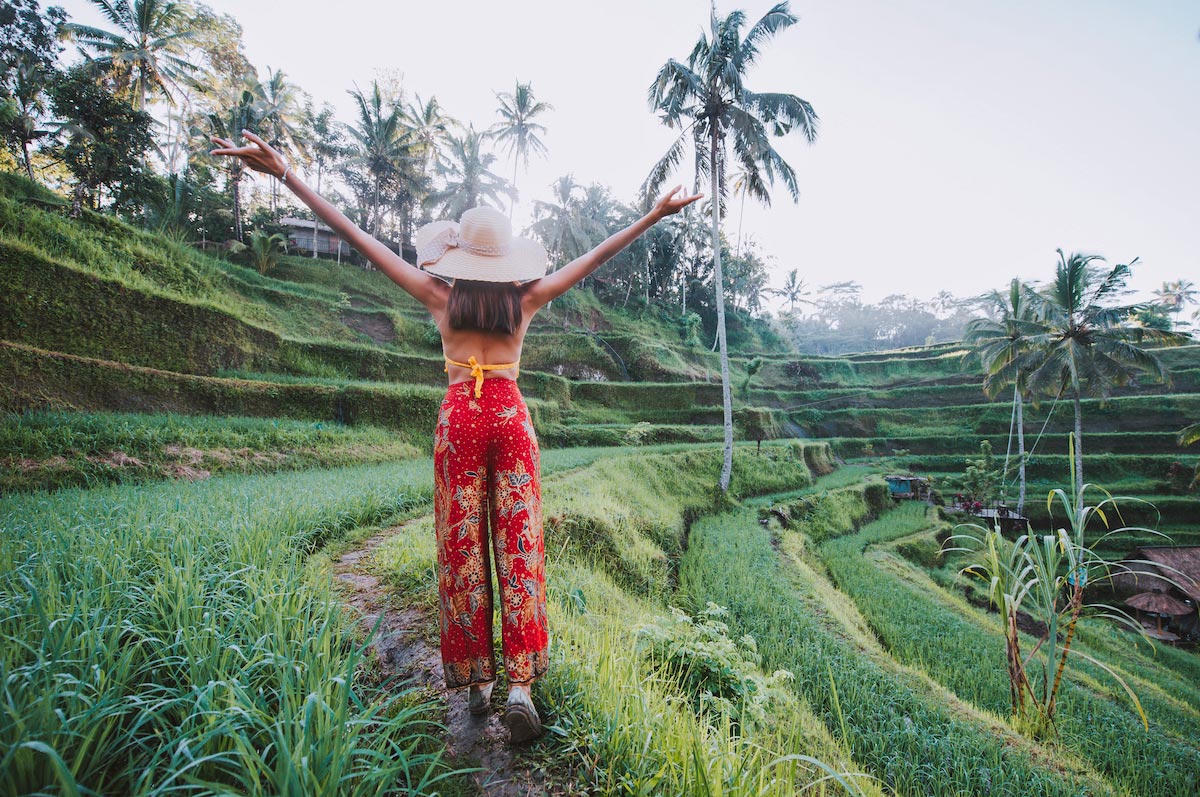Bali is known for a myriad of things such as alluring beaches, international DJ parties, and surfing, but nothing compares to its picturesque and world-famous rice terraces. Besides being a popular tourist attraction for people visiting Bali, it provides an insight into the way locals lead their lives. The rice terraces are not only breathtaking but are also a part of the country’s heritage and culture.
A Farming Community United by Water: The Subaks
Before we reveal our list of the most spectacular terraced rice fields in Bali, let us take the opportunity to learn a bit about the cultural value of these man-made spectacles, an aspect often overshadowed by their awe-inspiring visuality.
The ‘subaks’ are perhaps one of the oldest and most revered irrigation traditions in the country, and they were built to water the gorgeous terraces. History has it that people in the past were faced with the challenging task of farming on mountainous terrains and deep gorges. In their quest to find a solution to make these difficult terrains favorable for irrigation, the locals developed ‘subaks,’ a community of sharing water.
The tradition of creating subaks is alive and kicking even today, creating stunning and photogenic rice terraces. You can fill entire memory cards with wallpaper-worthy images and still not get enough of them. It’s nature and man’s hard work coming together to form a marvelous artwork. Although this luscious paradise is at its greenest best from October to March, which is the wet season in Bali, you can enjoy this visual masterpiece any time of the year, thanks to succession farming.
Visit the rice terraces early in the morning, before the birds, farmers, and visitors arrive, and your eyes will thank you for the sights they behold. If you want to see the greener, more inland side of the island, here are some of the recommended rice terraces you must visit during your stay:
#1. Jatiluwih in Tabanan, West Bali
Spread across 600 acres, yes you read it right, 600 acres, these breathtaking lush-green rice terraces are a UNESCO cultural heritage site. In Balinese, Jatiluwih can be literally translated to Jati (really) and Luwih (beautiful), a name with which we could not agree more. Created by the local people without the use of any machines or equipment, the traditional subak irrigation system is based on Tri Hita Karana philosophy that unites three worlds – nature, humans, and spirits.
View this post on Instagram
Located in Tabanan regency, about a two hour’s drive from Kuta, these unpolluted rice fields offer dramatic, lush greenery and a towering view of Mt. Batukaru. Because the area is a protected site, commercial developments are strictly controlled, preserving 70 percent of the land for rice plantation. This means that the terraces are sure to stay and be admired by future generations to come.
There are small idyllic restaurants nearby serving international and local food for travelers after a tiring day. Among the most popular, Gong Jatiluwih is a spacious open-pavilion restaurant right in the middle of the rice paddies. Despite its rustic appearance, from the neatly thatched roofs to the hand-carved furnishings, the place may surprise you with its famed specialty: wood-fire Italian pizza.
#2. Tegallalang, Jalan Raya, Ubud
The Tegallalang rice terraces are one of the most popular with visitors due to its easy accessibility from Ubud. If you Google ‘rice terraces in Bali’, Tegallalang would probably be the first thing that you will see. Although picturesque images of the landscape are spread far and wide, witnessing the landscape in person is a different experience altogether.
View this post on Instagram
There are plenty of good vantage points for taking pictures and the terraces are well-maintained by the locals. For a small price, the farmers would gladly pose for a picture or would even let you rent one of their rice field straw hats and other props. We highly recommend that you visit early in the morning or late in the afternoon when the terraces are blanketed by the golden sun rays.
Aside from the view, the area is dotted by local cafes serving food, refreshments, and ice cream, refreshing alternatives to Bali’s beach clubs and restaurants. Visit the wood-carving village of Pakudui just a short distance from the site, famed for their Garuda wood carvings and other world-class figurines.
#3. Rendang, East Bali
Rendang is a quaint little mountain village in the Karangasem regency that is blessed with outstanding views and verdant rice paddies. Bali’s most prominent mountain, Mt. Agung, looks down on the terraced valleys. Thanks to regular maintenance and succession farming method, visitors can find green paddy fields in Rendang any time of the year. The place offers a tropical countryside environment, an ideal get-away from the island’s beaches and urban districts.
https://www.instagram.com/p/B1fElt0joeb/
Interestingly, just as Tegallalang is famed for their wood carvings, Rendang village is home to stone carvers. You will find stone carvings and stone temples scattered along the roads. The skills have been passed down several generations and are still practiced by the locals alongside rice farming.
Aside from the terraces, the area is also lined with rivers that run along its valleys. For adrenaline junkies, the Telaga Waja rapids are one of the most popular spots for rafting.
#4. Sidemen, Karangasem, East Bali
If a visit to the popular Klungkung and Besikah temples is a part of your itinerary, stop by the rice terraces in Sidemen to see for yourself the exotic and breathtaking man-made work of art on the hilly terrains of Mt. Agung. When the terraces are flooded with water during the day with the sun shining on them, the beauty of the scenic landscapes is a view to behold. No wonder, the enormous plantations, and glittering rice paddies attract legions of travelers throughout the year.
View this post on Instagram
Many tours offer treks to the rice terraces where you can immerse your soul in the natural surrounding. When you visit the local village, don’t forget to buy the traditional dye weavings to take home with you as a unique memento.
Read our article about the 9 best souvenirs to bring home from Bali.
#5. Munduk Rice Fields in North Bali
The gorgeous Munduk rice terraces are situated less than two hours away from Ubud, and you need to drive all the way via the Mekarsari – Baturiti to get there. Munduk has gained popularity among tourists for its unspoiled natural beauty. But this charming rural area is also home to winsome rice terraces, stretching out for miles.
Due to its relatively less humid climate, Munduk once attracted the Dutch gentry during the colonial period; building their vacation homes, some of which may still be found today. Nowadays, a new set of foreigners flock to the area, this time to go on trekking tours to see the pristine forests, wildlife, and breathtaking waterfalls. A travel tip – Look for the local produce sold on stalls by the locals in the region. You can find fresh and organic fruits that are locally grown in the farms.







